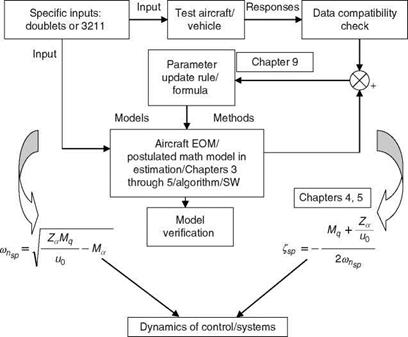CHAPTER HIGHLIGHTS
Chapter 2 introduces the concepts and methods of mathematical structures and model building for dynamic systems. The conventional transfer function (TF), time series, and state-space modeling aspects are treated. The delta-operator TF theory is highlighted. The new paradigms of ANNs – and FL-based modeling are also discussed. Uses of many of these model types are treated in subsequent chapters appropriately.
Chapter 3 deals with the EOM of aerospace vehicles, especially for aircraft, helicopters, and missiles. The solution of these equations provides the dynamic responses of the vehicle. Aerodynamic derivatives are the kernel of the EOM. Together these models capture the dynamic behavior of the vehicle in motion. Chapter 4 discusses the fundamental concepts of aerodynamic derivatives and
|
Maneuvers—Chapter 7 Measurements
|
▼
|
FIGURE 1.4 System synergy of maneuvers, parameter estimation, aerodynamic effects, and aircraft and control dynamics. |
models. Aerodynamic derivatives as the constituents of the aerodynamic model building are explained in detail to aid in better appreciation of the material in the later chapters. Chapter 5 resorts to simplification of the EOM, since these could be complicated and nonlinear. The simplified EOMs with embedded aerodynamic derivatives provide easier and better understanding of the behavior of the vehicle. It is here that some of the concepts and methods of Chapter 2 will be useful.
Chapter 6 discusses the concepts and approach to simulation of aircraft dynamics. Depending on the availability of detailed models of the subsystems of aircraft, simulation could be made simpler or more sophisticated. Its use in understanding the dynamics of a flying vehicle, in validating flight-control laws, and trying out parameter-estimation exercises need not be overemphasized. Chapter 7 briefly discusses the types of input excitation signals (commands) and flight-test maneuvers, which are an integral part of the flight-test exercises of an aircraft under certification or other special test trials. It also deals with the need for flight data generation for subsequent parameter estimation in the determination of aerodynamic derivatives.
Chapter 8 deals with the principles of reconfiguration/FL control since detailed treatment of flight control deserves a separate volume. Some modeling and analysis aspects of aircraft fault detection and identification are discussed. Several important features of modeling and design processes are outlined.
Chapter 9 deals with the concepts and methods of system identification and parameter estimation as applied to flight-test data. Some important methods are discussed and results of several practical case studies are also presented. Recent aspects of analytical global modeling and neural network – and FL-based parameter – estimation approaches are treated. A quick look at the companion volume [4] (and associated MATLAB SW) would be a good idea here.
Chapter 10 deals with the concepts of HQA of aircraft and helicopters. The HQA helps in the evaluation of aircraft design (though in a limited way), its dynamic behavior, and flight-control laws at the simulation stage as well as after the flight tests. For fighter/large transport aircraft and rotorcrafts, evaluation of pilot-vehicle interactions via HQA is very important in the early vehicle development/modification programs. Aspects of HQA and pilot-induced oscillations, better known as pilot – vehicle interactions, are also discussed in this chapter.
It would be, of course, necessary to have a reasonably good background in the basics of aerodynamics, linear control systems, and linear algebra. However, several important concepts related to aerodynamics of atmospheric vehicles, statistics and probability, and systems/signal are compiled in Appendices A, B, and C to support the material of Chapters 2 through 10.
Although enough care has been taken in working out the solutions of examples/ exercises and presentation of various concepts, theories, and case study results in the book, any practical applications of these should be handled with proper care and caution. Any such endeavors would be the reader’s own responsibility. MATLAB programs developed for illustrating various concepts, via examples in the book, would be accessible to the reader.















